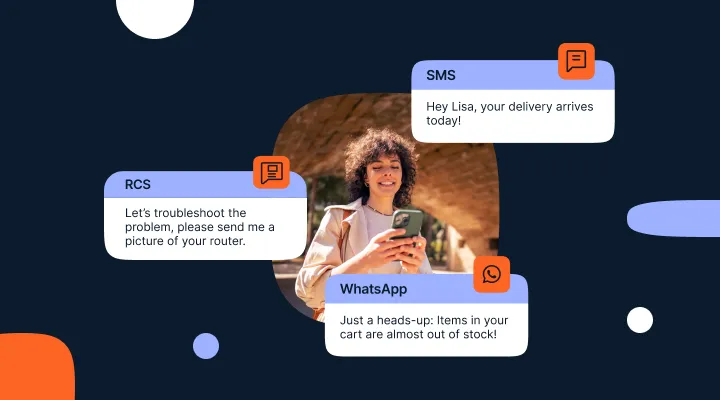Conversational AI vs. generative AI: An in-depth comparison
Let’s breakdown the differences between conversational AI and generative AI, and how they can work together to create better experiences for your customers.

To put it simply, generative AI creates new and unique content in different forms like text or images, while conversational AI produces human-like interactions through technology like voice bots or chatbots.
The chatter around AI certainly hasn’t slowed down. Brands all over the world are looking for ways to include AI in their day-to-day and in customer interactions. Generative AI and conversational AI have specifically dominated the conversation for B2C interactions – but we should dive a bit deeper into what they are, how brands can leverage them, and when.
What is conversational AI?
Conversational AI is a type of artificial intelligence (AI) that can mimic natural human language. It aims to provide a more human experience to users through chatbots or voice bots that can not only understand human speech and language but can also produce natural responses.
Examples of conversational AI
- Virtual voice assistants (Siri or Alexa)
- Customer support chatbots
- Conversational commerce assistants
- IT support
How it works – in one sentence
Conversational AI uses machine learning algorithms and natural language processing to dissect human speech and produce human-like conversations.
What is generative AI?
Generative AI is a type of artificial intelligence (AI) that can produce creative and new content. Its aim is to create unique and realistic content that does not yet exist, based on what has been learned from different sources of training data.
Examples of generative AI
- Text generation
- Image or video generation
- Code generation
- Translations
How it works – in one sentence
Generative AI uses algorithms trained on large datasets to learn patterns to create new content that mimics the style and characteristics of the original data.
Key differences between conversational AI and generative AI
| Purpose | Interacting in human-like conversations | Creating new and unique content |
| Language | Understands natural language and intent | Learns language patterns to create new content |
| Output | Responses for chatbots | Creates images, text, music, etc. |
| Use cases | Customer support and service | Generating new content based on input for marketing |
Benefits of conversational AI
- Availability: Chatbots powered by conversational AI can be available 24/7, answering customer questions and providing support any time of day or night. This is especially helpful for businesses that operate globally.
- Efficiency: Chatbots can handle a high volume of inquiries simultaneously, freeing up customer service agents for more complex issues.
- Faster time to resolution: Conversational AI chatbots provide immediate support to customers, meaning they don’t need to wait on hold or for an agent to pick up to solve their issue.
Limitations of conversational AI
- Misunderstandings: It’s possible that conversational AI chatbots might misunderstand users due to dialect and language differences or emotional components in a message if it was not trained for that.
- Limited capabilities: Conversational AI can’t handle every situation and may not be able to resolve complex customer service issues.
- Privacy concerns: Conversational AI interactions often involve collecting data, which raises privacy concerns for some users.
Benefits of generative AI
- Enhanced creativity: Generative AI acts as a powerful tool for artists, designers, and researchers. It can spark new ideas, generate variations on existing concepts, and help explore creative possibilities.
- Increased efficiency: Repetitive tasks like image editing or content creation can be automated by generative AI, freeing up human time and resources for more strategic tasks.
- Personalized experiences: Generative AI can personalize experiences by tailoring content or products to user preferences, leading to greater engagement and satisfaction.
Limitations of generative AI
- Ethical concerns: As AI-generated content becomes more sophisticated, issues around copyright, authenticity, and the ethics of creating deepfakes become more pressing.
- AI hallucinations: When an AI model creates false or illogical outputs that aren’t based on any real data but presents the information as fact.
- Data privacy and security: Generative AI relies on vast amounts of data, raising concerns about privacy breaches and the misuse of sensitive information used to train the models.
When should businesses use conversational AI vs generative AI
There are many applications today for both conversational AI and generative AI for businesses. While both use natural language processing to output human-sounding replies, conversational AI is more often deployed in customer service and chatbots, while generative AI creates new and unique content.
Summary of how businesses can use both types of AI:
| Conversational AI | Generative AI |
|---|---|
| Customer service chatbot | Translations |
| Voice bot support | Image generation (ie. for campaigns) |
| Shopping assistants | Text generation (ie. for emails or newsletters) |
| Appointment scheduling | Summarization of conversations with live agents |
| Insurance claim submission | Generate quick replies for live agents |
Generative AI can be incredibly helpful to create conceptual art or generate content ideas for pre-planning. However, the output is often derivative, generic, and biased since it is trained on existing work. Worse, it might even produce wildly inaccurate replies or content due to ‘AI hallucination’ as it attempts to create plausible-sounding falsehoods within the generated content.
With its smaller and more focused dataset, conversational AI is better equipped to handle specific customer requests. For example, a telco customer seeking help for a technical issue would be better served with a telco chatbot that already has a pool of solutions and answers specific to the problem from that specific telco. Generative AI would pull information from multiple training data sources leading to mismatched or confused answers.
That’s why it is critical in any situation to keep a human-in-the-loop, to ensure the outputs of your AI solution is accurate, ethical, and in line with your brand.
Conversational commerce and AI
The technology behind generative AI is still relatively new, so brands looking to utilize AI within their businesses would be better off with more mature and proven conversational commerce solutions to offer customers the best experiences.
Many APAC brands and organizations today already utilize conversational commerce solutions powered by conversational AI and the cloud, using a Conversational Experience Platform to build end-to-end automated journeys.
70%
of APAC organizations plan to increase spending in conversational commerce solutions over 2023-2024 to provide more personalized customer experiences.
It’s no surprise to see growing adoption of conversational commerce among businesses and even government organizations since conversational commerce can reduce customer service costs by upwards of 30%.
Some use cases for conversational commerce include:
- Abandoned cart recovery
- Encourage second purchases
- Collect orders
- Order confirmations
- Processing returns
Brands that used conversational AI and generative AI solutions
Bloomsy Box
In a recent collaboration with Masters of Code, a floral subscription company, Bloomsy Box, was able to launch a Mother’s Day campaign with a generative AI eCommerce chatbot that created personalized greeting cards to the winners of its daily floral bouquet giveaway.
By utilizing GPT-powered conversational experiences, brands can integrate an intelligent AI assistant without having to know a single line of code while customers receive unique contest experiences tailormade for them.
LAQO
This fully digital insurance brand launched a GenAI powered conversational chatbot to assist customers with FAQs and insurance claims. The chatbot character, Pavle, conveyed the brand’s unique style, tone of voice, and humor that made the chatbot not only helpful but humanly engaging for users.
The AI assistant has transformed the way LAQO approaches customer service. Using both generative AI technology and conversational AI design, a unique and user-friendly solution that meets the needs of insurance clients.
LAQO’s conversational chatbot took 30% of the load off live agents and can resolve 90% of all queries within 3-5 messages, making time to resolution much faster for users.

Coolinarika
Croatia’s largest and most popular culinary platform deployed a conversational chatbot that was trained on the platform’s vast number of healthy recipes and nutritional information. The engaging chatbot can interact with users to help educate them on healthy eating and provide nutritional recipes to encourage better lifestyle choices.
Since the launch of the conversational chatbot, Coolinarika saw over 30% boost in time spent on the platform, and 40% more engaged users from gen Z.

Finding a solution provider for conversational AI experiences
Integrating an omnichannel CPaaS solution is never easy but fortunately, there are many experienced, well-established technology solution vendors that can help you get started with conversational commerce.
Infobip offers a wide range of solutions to aid and support in conversational transformation:
Infobip continues to invest in automation, frameworks around ChatGPT, and enhanced self-serve and security features. This is ideal for international customers seeking an experienced conversational commerce partner with a strong global presence.
Learn about how conversational commerce can elevate your business
CX through conversational commerce eBookA (very) brief history of AI
Get the latest insights and tips to elevate your business
By subscribing, you consent to receive email marketing communications from INFOBIP. You have the right to withdraw your consent at any time using the unsubscribe link provided in all INFOBIP’s email communications. For more information please read our Privacy Notice
Keep on exploring
Read some of our latest blog posts

The ultimate guide to generative AI chatbots for customer service
Learn how generative AI, agentic AI, and agentic RAG technology are transforming CX. Explore use cases, benefits, risks, and best practices.

Chatbots vs. conversational AI: Exploring the differences
Discover the differences, benefits, and uses of chatbots and conversational AI to transform your business and enhance customer engagement.

Generative AI security: How to keep your chatbot healthy and your platform protected
Discover essential strategies to secure AI chatbots from evolving GenAI threats. Learn how to protect your AI investments now and keep them healthy and thriving.

Alyasra Fashion: Building strong customer relationships through personalization
Alyasra Fashion is setting new customer satisfaction and convenience standards with its personalized approach. Learn how.

How Carrefour is transforming the shopping experience with conversational retail
Carrefour is leveraging conversational retail to transform the way we shop. Dive into the new era of customer service and personalized interactions.

How to get the benefits of generative AI without the risk
How businesses can get the benefit of generative AI without the risk of becoming tomorrow’s news headline when it goes wrong.









